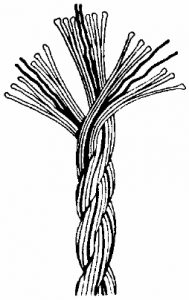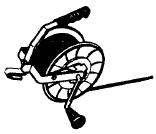Fences that Work: Temporary Electric Fence Materials Evaluation
(Lesson 3. Fencing Systems continued)
Temporary electric fences give livestock producers a powerful tool for pasture management. They consist of one or more flexible wires attached to insulated posts and charged with an energizer. The fences can be put up and taken down quickly.
Cutting Through the Propaganda
Some of the sales literature fencing companies provide is very informative and can help you design more effective electric fences.
Other sales literature can be confusing. Predictably every manufacturer claims their product to be superior to all others.
Temporary Electric Fence Types
There are three basic types of temporary electric fence products: polywire, polyrope, and polytape. Polywire is a generic term referring to any of several brands of electroplastic twine. Polytape refers to electroplastic ribbon. Most polywires and polytapes are made up of stainless steel filaments interwoven with some polyethylene, polypropylene, or polyester fibers. The number of steel or aluminum strands varies from 3 to 9 depending on the product.
Maxishock cable is also marketed as a temporary portable fence wire. It consists of 7 strands of galvanized steel woven into a flexible cable.
Voltage drops sharply in steel/polyethylene wires when over 1/2 mile from the energizer. Voltage in a fence with the aluminum/fiberglass material does not drop significantly when measured one mile from the energizer under field conditions. Aluminum is a better electrical conductor than steel. In addition, aluminum does not rust. However in thin filaments, it corrodes and becomes brittle – not a good choice
Maxishock cable was stronger and more conductive than the other products. It is also heavier, bulkier, and more cumbersome to dispense and rewind.

Polytape is more visible than polywire. However, it is also bulkier (a full reel of polywire builds more fence than the same reel full of polytape). Polytape is slightly more difficult to rewind, and it wears out more rapidly than polywire. Use polytape where visibility is important (horses); polytape comes in different widths depending on your use. Polyrope is a 3/8 inch braided rope with nine metal strands braided into the rope. Polyrope has some advantages over polytape since it is more visible and will not flutter in the wind. Use polywire for all other applications, especially multiple wire fences.
Number of Conductive Strands
Predictably the six wire polywires were more conductive than the three strand materials. The nine strand polywires were more conductive than the 6 strand products. The nine strand polywires are stronger than the other products. However, the nine strand materials are bulkier and slightly more difficult to rewind. A full reel of nine-strand wire holds about 300 feet less wire than the same reel loaded with 6-strand material. The nine-strand polywire was also more expensive.
Under most applications six conductive steel filaments is plenty to do the job. While the nine-strand material is stronger, you don’t need strength for an effective psychological barrier.
Color
If an animal doesn’t see the wire they can’t respect it. Visibility is critical, especially with poorly trained stock or where wildlife may challenge fences. Polywire comes in several colors and color combinations: white, black and white, orange, orange and black, yellow, and yellow and black. Orange and yellow wires look best on the farm supply store shelf but in the field white has them beat hands down. Against a lush green or dried yellow background, white is more visible. Time and time again untrained animals noticed white polywire from farther away than they noticed other colors. Buy white polywire unless you have to deal with snow for part of the year. In snow country use black and white or colored polywire. Black and white combo is best for all visibility.
Reels

A reel is essential. Rolling polywire back on the spool, on a stick or around your arm (the way you would roll an extension cord) simply won’t work. You’ll wind up kicking the dog, yelling at the kids and having nightmares about the money you’ve wasted and the mess you made.
Reels with steel cranks cost about $10 more than reels with plastic cranks. Spend the money. A reel should be able to take a little abuse, after all this is for use on a farm, not a china shop.
Posts

Metal “t” posts are the strongest, but most labor intensive to install and remove–a distinct disadvantage for temporary portable electric fences. The “t” posts also required insulators.
Fiberglass rods are easily tapped in with a hammer. Rod ends splintered when tapped. Fence suppliers sell a cap to place over the end of the rods to protect them when you tap them in. An expended shotgun shell works equally well and doesn’t cost anything. Ultraviolet resistant coatings are now available on fence posts to reduce the chance of fiberglass splintering over time. It is recommended to store posts inside when not in use.
Polywire is attached to the rods using a wire clip or plastic insulators that slide on the rods. There are several types of wire clips. Some clips are difficult to adjust. The plastic insulators are most difficult to adjust in the field. Clips made for use with polytape (with an extra wide area to hold the wire) were easy to adjust and have a useful locking feature.
There are many kinds of tread-in posts. Lightweight fiberglass posts with one stationary and two adjustable clips did not go into the soil as easily as the two other tread-in post styles. Lightweight and heavyweight polyethylene tread-in posts with wire loops molded into the post and a steel spike at the bottom are also available. By stepping on a small platform at the base of the posts the spike tip went in easily and adequately secured the post. Under dry conditions they are difficult and sometimes impossible to install. The premolded loops provide plenty of flexibility for a variety of wire spacings.
For wetter ground it is difficult to beat the convenience of the tread-in posts with premolded loops (either lightweight or heavy duty). However they are more expensive than the fiberglass rods. Fiberglass rods make just as effective a fence but take a little longer to install. They are more versatile since they can be used under all conditions. Carry an empty shotgun shell case or fiberglass rod cap with you to place over the top of rods when you tap them in.
